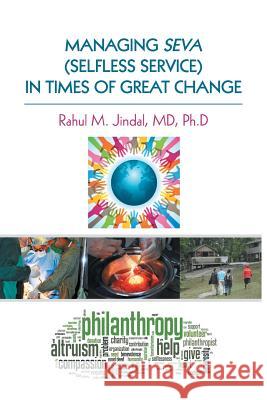Managing Seva (Selfless Service) in Times of Great Change » książka
Managing Seva (Selfless Service) in Times of Great Change
ISBN-13: 9781491781531 / Angielski / Miękka / 2015 / 288 str.
The first part of the book gives practical aspects of performing seva in the USA, India and Guyana, South America. I give case histories from my own experience and how I navigated the turbulent waters to deliver what we set out to accomplish. I hope that our team's work will motivate others to understand the difficulties and find solutions to fulfilling the goal of seva. At the end, we could not achieve anything without the help of dedicated team members many of whom gave up their vacations and willingly gave their money and energy to make a difference. The second part of the book examined 5 case studies of our work dealing with kidney and corneal transplants in Guyana, blood and bone marrow drives in the USA under the auspices of the Hindu Mandir Executive Committee, distance learning in the UK and the Global Energy Parliament, Kerala, India. The third part of the book gives cautionary lessons in managing seva projects across the world. The fourth part of the book gives theoretical aspects of seva, which include social networks in management of complex missionary projects, the use of social networking technology in the promotion and scaling up of complex global health initiatives, the growing phenomenon of "voluntourism" and Distance Learning. Our case histories represent a variety of situations across continents. Having initiated and carried these projects from scratch to fruition has given us an insight into the many issues others may face when they initiate their own projects. We experienced frustration at many points in the trajectory of our projects; however, we persevered and perhaps achieved modest success. We should confess that we thought of abandoning and giving up at multiple stages of our projects, however, we were reminded of the beneficiaries and continued against many odds and obstacles. Some of these could have been prevented but others were inevitable.
The first part of the book gives practical aspects of performing seva in the USA, India and Guyana, South America. I give case histories from my own experience and how I navigated the turbulent waters to deliver what we set out to accomplish. I hope that our teams work will motivate others to understand the difficulties and find solutions to fulfilling the goal of seva. At the end, we could not achieve anything without the help of dedicated team members many of whom gave up their vacations and willingly gave their money and energy to make a difference.The second part of the book examined 5 case studies of our work dealing with kidney and corneal transplants in Guyana, blood and bone marrow drives in the USA under the auspices of the Hindu Mandir Executive Committee, distance learning in the UK and the Global Energy Parliament, Kerala, India.The third part of the book gives cautionary lessons in managing seva projects across the world.The fourth part of the book gives theoretical aspects of seva, which include social networks in management of complex missionary projects, the use of social networking technology in the promotion and scaling up of complex global health initiatives, the growing phenomenon of "voluntourism" and Distance Learning. Our case histories represent a variety of situations across continents. Having initiated and carried these projects from scratch to fruition has given us an insight into the many issues others may face when they initiate their own projects. We experienced frustration at many points in the trajectory of our projects; however, we persevered and perhaps achieved modest success. We should confess that we thought of abandoning and giving up at multiple stages of our projects, however, we were reminded of the beneficiaries and continued against many odds and obstacles. Some of these could have been prevented but others were inevitable.











